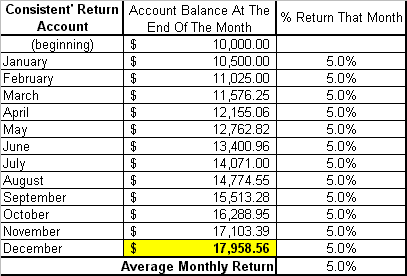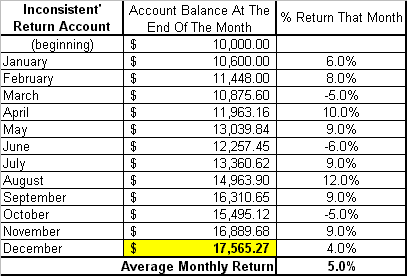One of the widely accepted conventions of trading is that erratic returns are just part of the game. Some trades will be great, some will be mediocre, and some will be awful. But if you want to make it big in trading, you have to be willing to take some losses if you want to make some big profits, right? Think again. When given the choice, you may want to be consistently profitable in small ways, rather than hit the occasional 'homerun'. In the following example, we'll compare the difference between the two types of trading.
In our first scenario, we start with a trading account worth $10,000. We'll say we get an 5% return each month on the previous month's balance. After doing this for twelve months, we end up with an account balance of $17,958.56, or a 79.6% return for the year. That's not bad for an average monthly return of 5%.
Consistent Account - Average of 5% per Month

On the other hand, we could 'go for broke' with our $10,000 account. Here we'll be highly aggressive in search of big rewards, and we'll just deal with the fact that some months will be rough. That, after all, is the price you have to pay to get those stellar returns, right? After twelve volatile months, we've actually gotten the same monthly average return of 5% - we've just done it erratically. Even with the same monthly monthly average, those few bad months really took their toll. This volatile account only achieved a 75.6% return - considerably less less than our consistent account that gave us 5% per month.
Inconsistent Account - Average of 5% per Month

This is a testament to the importance of consistency, and capital preservation. In our second scenario, the reason the great months didn't help was because we had less capital to invest following a losing month. Remember, it takes a 100% gain to offset a 50% loss. And while the difference between these two returns may seem trivial, if you compound this over several years, it suddenly won't seem trivial. In fact, the difference between these two portfolios after five years of the same kind of consistent (or inconsistent) returns is nearly $20,000
By the way, it doesn't matter how you sequence your gains and losses in scenario two - the average monthly return and the bottom line remain the same. Don't plan on taking your losses early and 'making up for them later', as it just won't help any.
Not every winner has to be huge, but a few huge losses can sure knock you out of the game. Using tight stops and setting reasonable targets will help you stay consistent, and that's critical to trading success.
P.S. I'd love to receive feedback from you. Please leave a comment or discuss the article by clicking on "Make a comment on this article" below.
Price Headley is the founder and chief analyst of BigTrends.com.